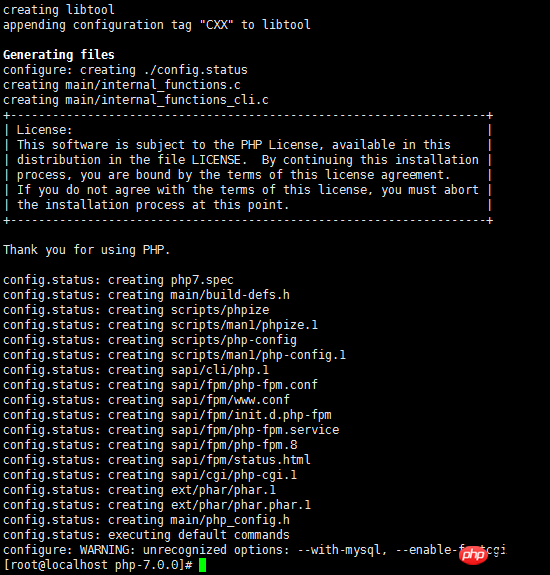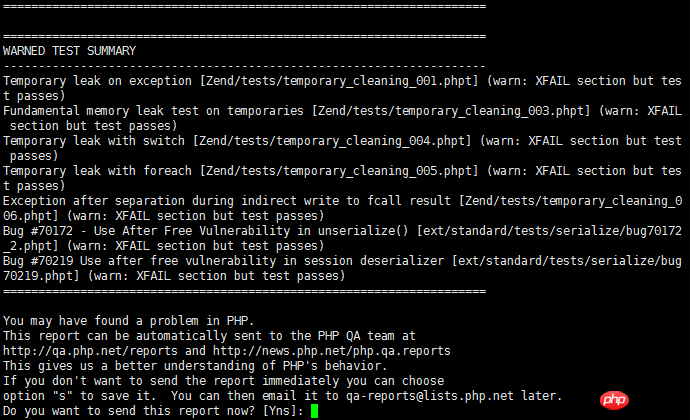
Erstellen Sie zunächst einen Benutzer namens php ohne Anmeldeberechtigung und eine Benutzergruppe namens php
#######新建php用户和php组[root@localhost ~] # groupadd -r php && useradd -r -g php -s /bin/false -d /usr/local/php7 -M php
Kompilieren und installieren Sie das libmcrypt-, mhash- und mcrypt-Binärquellpaket
Der Grund, warum libmcrypt hier kompiliert und installiert wird, liegt darin, dass die Yum-Installation anscheinend einen Fehler meldet
######编译安装libmcrypt-2.5.7 [root@localhost ~]# tar zxvf libmcrypt-2.5.7.tar.gz [root@localhost ~]# cd libmcrypt-2.5.7 [root@localhost libmcrypt-2.5.7]# ./configure --prefix=/usr/local/related/libmcrypt [root@localhost libmcrypt-2.5.7]# make && make install [root@localhost libmcrypt-2.5.7]# cd ~ [root@localhost ~]# rm -rf libmcrypt-2.5.7*
######编译安装mhash-0.9.9.9 [root@localhost ~]# tar zxf mhash-0.9.9.9.tar.gz [root@localhost ~]# cd mhash-0.9.9.9 [root@localhost mhash-0.9.9.9]# ./configure --prefix=/usr/local/related/mhash [root@localhost mhash-0.9.9.9]# make && make install [root@localhost mhash-0.9.9.9]# cd ~ [root@localhost ~]# rm -rf mhash-0.9.9.9*
######编译安装mcrypt-2.6.8 [root@localhost ~]# tar zxf mcrypt-2.6.8.tar.gz && cd mcrypt-2.6.8 [root@localhost mcrypt-2.6.8]# export LD_LIBRARY_PATH=/usr/local/related/libmcrypt/lib:/usr/local/related/mhash/lib [root@localhost mcrypt-2.6.8]# export LDFLAGS="-L/usr/local/related/mhash/lib -I/usr/local/related/mhash/include/" [root@localhost mcrypt-2.6.8]# export CFLAGS="-I/usr/local/related/mhash/include/" [root@localhost mcrypt-2.6.8]# ./configure --prefix=/usr/local/related/mcrypt --with-libmcrypt-prefix=/usr/local/related/libmcrypt [root@localhost mcrypt-2.6.8]# make && make install [root@localhost mcrypt-2.6.8]# cd ~ [root@localhost ~]# rm -rf mcrypt-2.6.8*
######其他依赖yum安装[root@localhost ~] # yum -y install libxml2 libxml2-devel openssl openssl-devel curl-devel libjpeg-devel libpng-devel freetype-devel
Hinweis: Sie müssen zuerst den Kommentar-Text entfernen, der nach dem Backslash „“ unten hinzugefügt wurde! ! !
######生成配置文件 [root@localhost ~]# tar -zxf php-7.0.0.tar.gz && cd php-7.0.0 [root@localhost php-7.0.0]# ./buildconf --force Forcing buildconf Removing configure caches buildconf: checking installation... buildconf: autoconf version 2.69 (ok) rebuilding configure rebuilding main/php_config.h.in ######开始配置 [root@localhost php-7.0.0]# ./configure \ --prefix=/usr/local/php7 \ [PHP7安装的根目录] --exec-prefix=/usr/local/php7 \ --bindir=/usr/local/php7/bin \ --sbindir=/usr/local/php7/sbin \ --includedir=/usr/local/php7/include \ --libdir=/usr/local/php7/lib/php \ --mandir=/usr/local/php7/php/man \ --with-config-file-path=/usr/local/php7/etc \ [PHP7的配置目录] --with-mysql-sock=/var/run/mysql/mysql.sock \ [PHP7的Unix socket通信文件] --with-mcrypt=/usr/include \ --with-mhash \ --with-openssl \ --with-mysql=shared,mysqlnd \ [PHP7依赖mysql库] --with-mysqli=shared,mysqlnd \ [PHP7依赖mysql库] --with-pdo-mysql=shared,mysqlnd \ [PHP7依赖mysql库] --with-gd \ --with-iconv \ --with-zlib \ --enable-zip \ --enable-inline-optimization \ --disable-debug \ --disable-rpath \ --enable-shared \ --enable-xml \ --enable-bcmath \ --enable-shmop \ --enable-sysvsem \ --enable-mbregex \ --enable-mbstring \ --enable-ftp \ --enable-gd-native-ttf \ --enable-pcntl \ --enable-sockets \ --with-xmlrpc \ --enable-soap \ --without-pear \ --with-gettext \ --enable-session \ [允许php会话session] --with-curl \ [允许curl扩展] --with-jpeg-dir \ --with-freetype-dir \ --enable-opcache \ [使用opcache缓存] --enable-fpm \ --enable-fastcgi \ --with-fpm-user=nginx \ [php-fpm的用户] --with-fpm-group=nginx \ [php-fpm的用户组] --without-gdbm \ --with-mcrypt=/usr/local/related/libmcrypt \ [指定libmcrypt位置] --disable-fileinfo
Die Ergebnisse der Ausführung des obigen Konfigurationsbefehls sind wie folgt: 
[root@localhost php-7.0.0]# make clean && make && make install
PHP 7 erfolgreich kompiliert und installiert 
Dies ist ein nicht wesentlicher Schritt. Führen Sie den Befehl „make test“ aus

Da Sie mit MySQL kommunizieren müssen, müssen Sie nach der Installation von PHP7 speziell das Verzeichnis der lib-Erweiterungsbibliothek überprüfen ( /usr/local/php7/ lib/php/extensions/no-debug-non-zts-20151012/). Sie müssen sicherstellen, dass mindestens zwei dynamische Bibliotheksdateien mysqli.so und pdo_mysql.so vorhanden sind, wie in der folgenden Abbildung dargestellt.
[root@localhost php-7.0.0]# ls -lrt /usr/local/php7/lib/php/extensions/no-debug-non-zts-20151012/

Verwendet Kopieren Sie die kompilierte Konfigurationsdatei in das PHP7-Konfigurationsverzeichnis (/usr/local/php7/etc/). Es wird empfohlen, die Konfiguration in Github zu verwenden. Diese Konfiguration stammt aus „Konfiguration von php.ini, php-fpm und www.conf in PHP7“
#######方法一:直接使用编译后未经优化处理的配置 [root@localhost php-7.0.0]# cp php.ini-production /usr/local/php7/etc/php.ini [root@localhost php-7.0.0]# cp /root/php-7.0.0/sapi/fpm/init.d.php-fpm /etc/init.d/php-fpm [root@localhost php-7.0.0]# cp /usr/local/php7/etc/php-fpm.conf.default /usr/local/php7/etc/php-fpm.conf [root@localhost php-7.0.0]# cp /usr/local/php7/etc/php-fpm.d/www.conf.default /usr/local/php7/etc/php-fpm.d/www.conf #######方法二:使用https://github.com/lizer2014/mylnmp/tree/master/PHP文中的配置 [root@localhost php-7.0.0]# mv ~/php.ini /usr/local/php7/etc/php.ini && mv ~/php-fpm /etc/init.d/php-fpm [root@localhost php-7.0.0]# mv ~/php-fpm.conf /usr/local/php7/etc/php-fpm.conf && mv ~/www.conf /usr/local/php7/etc/php-fpm.d/www.conf
Hinweis: Sie müssen die Parameter in der php.ini-Konfiguration ändern und ändern extension_dir zu Ihrem eigenen
extension_dir = "/usr/local/php7/lib/php/extensions/no-debug-non-zts-20151012/"
In /etc/init.d/php-fpm muss vor dem Daemon-Prozess der Startfunktion ein Befehl make /var/run/php-fpm vorhanden sein Andernfalls führt ein Neustart des Servers zu einem Startfehler. Die Konfiguration in Nginx weist ebenfalls dieses Problem auf
[root@localhost php-7.0.0]# echo -e '\nexport PATH=/usr/local/php7/bin:/usr/local/php7/sbin:$PATH\n' >> /etc/profile && source /etc/profile
Stellen Sie unter anderem den Benutzer und die Benutzergruppe des PHP-FPM-Prozessverzeichnisses auf nginx ein und erstellen Sie das PHP-Sitzungsverzeichnis
#######设置PHP日志目录和php-fpm的运行进程ID文件(php-fpm.sock)目录 [root@localhost php-7.0.0] # groupadd -r nginx && useradd -r -g nginx -s /bin/false -M nginx [root@localhost php-7.0.0] # mkdir -p /var/log/php-fpm/ && mkdir -p /var/run/php-fpm && cd /var/run/ && chown -R nginx:nginx php-fpm #######修改session的目录配置 [root@localhost run]# mkdir -p /var/lib/php/session [root@localhost run] # chown -R nginx:nginx /var/lib/php
######配置开机自启动,增加到主机sysV服务 [root@localhost run]# chmod +x /etc/init.d/php-fpm [root@localhost run]# chkconfig --add php-fpm [root@localhost run]# chkconfig php-fpm on ######测试PHP的配置文件是否正确合法 [root@localhost run]# php-fpm -t [05-Dec-2015 17:33:03] NOTICE: configuration file /usr/local/php7/etc/php-fpm.conf test is successful
Nach Abschluss der oben genannten Vorgänge können Sie den PHP-Dienst offiziell verwenden. Der Befehl zum Starten des PHP-Prozessdienstes lautet wie folgt:
[root@localhost init.d]# service php-fpm startStarting php-fpm done
Anschließend können Sie mit dem Befehl ps -aux|grep php (die Anzahl der PHP-FPM-Prozesse und den Prozessbenutzer) überprüfen, ob er erfolgreich ist nginx im Bild werden beide durch www.conf bestimmt. Die Werte von pm.start_servers und user werden jeweils bestimmt):

Schließlich können Sie die aktuellen PHP-Versionsinformationen über den Befehl php -v anzeigen. Auf dem Bild können Sie sehen, dass PHP7 derzeit auch den Zend OPcache-Cache verwendet, da die Konfiguration zend_extension=opcache.so zur Datei php.ini hinzugefügt wird.

Verwandte Artikel:
Mac verwendet standardmäßig seine eigene PHP-Installation
centos6.7 Installation Detaillierte Einführung in PHP7
Das obige ist der detaillierte Inhalt vonDetaillierte Einführung in den Beispielcode zum Kompilieren und Installieren von PHP7 unter CentOS7 (Bild). Für weitere Informationen folgen Sie bitte anderen verwandten Artikeln auf der PHP chinesischen Website!




